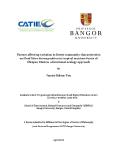Factors affecting variation in forest community characteristics and leaf-litter decomposition in tropical montane forest of Chiapas, México A functional ecology approach
Fecha de publicación
2016Autor
Bolom-Ton, Fausto
Tipo
Tesis de doctorado
Metadatos
Mostrar el registro completo del ítemDescripción
Tesis (doctorado) -- CATIE. Escuela de Posgrado. Turrialba (Costa Rica) ; Bangor University, Bangor (Reino Unido), 2016
Resumen
A functional ecology approach was combined with floristic studies to seek increased ecological understanding of forest characteristics and processes in the Central Highlands of Chiapas State, Mexico. The study had two main aims: 1) to determine the major ecological factors driving the floristic and functional variation of forest ecosystems, with emphasis on the operation of either environmental (niche model) or spatial (dispersal limitation model) factors and 2) to determine the relationship of leaf-litter decomposition rates to both leaf functional traits and forest conditions. For this, the specific objectives were i), characterise both the dominant species and the forest stands they form using functional traits, determining also the trait-trait and species-trait relationships; ii), characterise the floristic and functional variation amongst forest stands, and the relationship of this variation with spatial and environmental variables; iii) determine the influence of spatial factors, climate variables, anthropogenic disturbance, forest canopy openness and the traits of species on the abundance of saplings and iv), determine the effect of species leaf trait values, forest type, and their interaction, on leaf-litter decomposition. The study area encompassed a narrow altitudinal range from 2100 to 2800 m a.s.l., located on a carboniferous limestone substrate with abrupt topography and a cool and humid climate. For objectives i), ii) and iii), both adult trees and saplings were counted, measured and identified in field plots in four previously-defined forest types –oak forest, pine-oak forest, pine forest and broadleaved forest– at seven study sites. Plots were characterised in terms of spatial location, altitude above sea level and climate variables from Worldclim climate surfaces. Leaf, stem and whole-plant traits, as well as leaf carbon fractions, were measured for dominant species, and saplings were sampled under both closed and open canopies. For objective iv), first, leaf litter decomposition rates of 20 dominant species were measured in a greenhouse experiment for the assessment of trait effects and second, decomposition rates of representative litter from each forest type, plus two standard species, were measured in a field experiment using forest type as the main factor. Forests of the study area are a mosaic in which three main functional groups of species were identified (objective i). Two groups were respectively dominated by Quercus species and Pinus species, which both reach the canopy or sub-canopy layers of the forests and had high wood density, leaf dry matter content (LDMC) and other trait values suggesting relatively slow growth. The third group contained a wide taxonomic range of species that generally develop in the forest understorey and had high specific leaf area, leaf nutrient contents and other trait values suggesting relatively high rates of growth and population turnover. These three functional groups of species form a variety of floristic assemblages, ranging from those of simple structure and low floristic diversity (mostly pine forests) to complex and diverse broad-leaved forests. Most oak and pine-oak forests had intermediate characteristics. Variation partitioning analysis showed that the floristic variation of both adults and saplings was related to climate but also to spatial factors, suggesting an important role of dispersal limitation in the shaping of species assemblages (objectives ii and iii). In contrast, variation partitioning also showed that forest functional characteristics –measured using weighted mean trait values– were strongly linked to human disturbance, suggesting that people have had strong effects on the ecological functions of these forests (objective ii). Additionally, floristic variation among
viii
forest stands was not always accompanied by functional variation, suggesting that floristics can change across space while forest functional characteristics remain relatively homogeneous. Regarding objective (iii), leaf area was the only species functional trait with a clear relationship to the absolute densities of saplings, suggesting that the abundance of regeneration increases with increasing leaf area, though the effect of canopy openness was small. Finally, for objective iv), the greenhouse experiment showed that Quercus spp. and Pinus spp. with tough leaves had relatively slow decomposition rates and species with lower LDMC and associated tradeoffs in trait values, such as high specific leaf area, had higher decomposition rates. In the field experiment (objective iv), decomposition rates did not vary significantly between the four different forest types, supporting the hypothesis that persistent leaf characteristics of species, rather than forest functional characteristics and environment, are the most important controls on decomposition. Nevertheless, there was evidence that litter mixtures tended to show higher decomposition rates in forest associations where they were collected, than in other forest associations (the “home-field advantage” hypothesis). This result suggests probable variations in leaf-litter substrates determined by forest functional composition. It is believed that this is the first study to apply a functional traits approach to understanding variation of forest ecological characteristics and processes in Mesoamerican mountains. The study shows that dispersal limitation, as well as environmental and anthropogenic factors, probably influences the characteristics of forest stands, and that the degree of functional variation may be smaller than that of floristic variation. The study demonstrates that leaf trait values of dominant tree species influence litter decomposition rates and therefore, potentially, nutrient cycling. Even though litter decomposition rates in the field were most likely to be affected by leaf and litter characteristics, not forest environment, there was evidence for a home-field advantage effect. In the current era of anthropogenic global change effects on the forests of Chiapas, this work sheds new light on forest function and forest change and has special relevance for the design of conservation strategies for the tropical montane ecosystems.
Palabras clave
Editor
CATIE, Turrialba (Costa Rica)
URI (Enlace permanente para citar o compartir este ítem)
https://repositorio.catie.ac.cr/handle/11554/8588Colecciones
- Tesis [3046]


